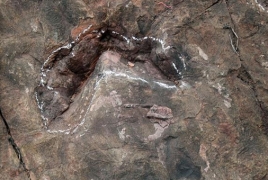
Scientists think they may have found a new candidate for the Jurassic period's biggest dinosaur, CNet reports.
A new study published Thursday, September 27 in Current Biology reveals that Ledumahadi mafube, a Brontosaurus relative, could have weighed 12 metric tons. That's approximately 26,000 pounds. Its fossils were discovered in South Africa.
A different dinosaur called the Argentinosaurus huinculensis has been previously cited by other scientists as being the largest dinosaur at approximately 80 tons (160,000 pounds), and lived during the Late Cretaceous period around 99.6 million years ago.
But during the Jurassic period, the Ledumahadi mafube was king.
It was discovered by a team of international scientists led by researchers from the University of the Witwatersrand in Johannesburg, South Africa. Ledumahadi mafube means "a giant thunderclap at dawn" in the official South African indigenous language of Sesotho, spoken by the Basotho people.
The Ledumahadi is considered a close relative of sauropod dinosaurs like the well-known Brontosaurus. Scientists believe the Ledumahadi dinosaur walked on all four legs and was an herbivore.
The researchers also determined from their findings that Ledumahadi was a "transitional" dinosaur, which means it was evolving steadily during the early Jurassic period.
In comparison with other sauropod dinosaurs like the Brontosaurus, the forelimbs of this new dinosaur are more "crouched" and thicker to support the weight of its giant body.
"The first thing that struck me about this animal is the incredible robustness of the limb bones," Blair McPhee, lead study author, said in a statement. "It was of similar size to the gigantic sauropod dinosaurs, but whereas the arms and legs of those animals are typically quite slender, Ledumahadi's are incredibly thick."
The new findings from the study of the fossils also show that the Ledumahadi roamed the Earth earlier than sauropods -- around 200 million years ago.

